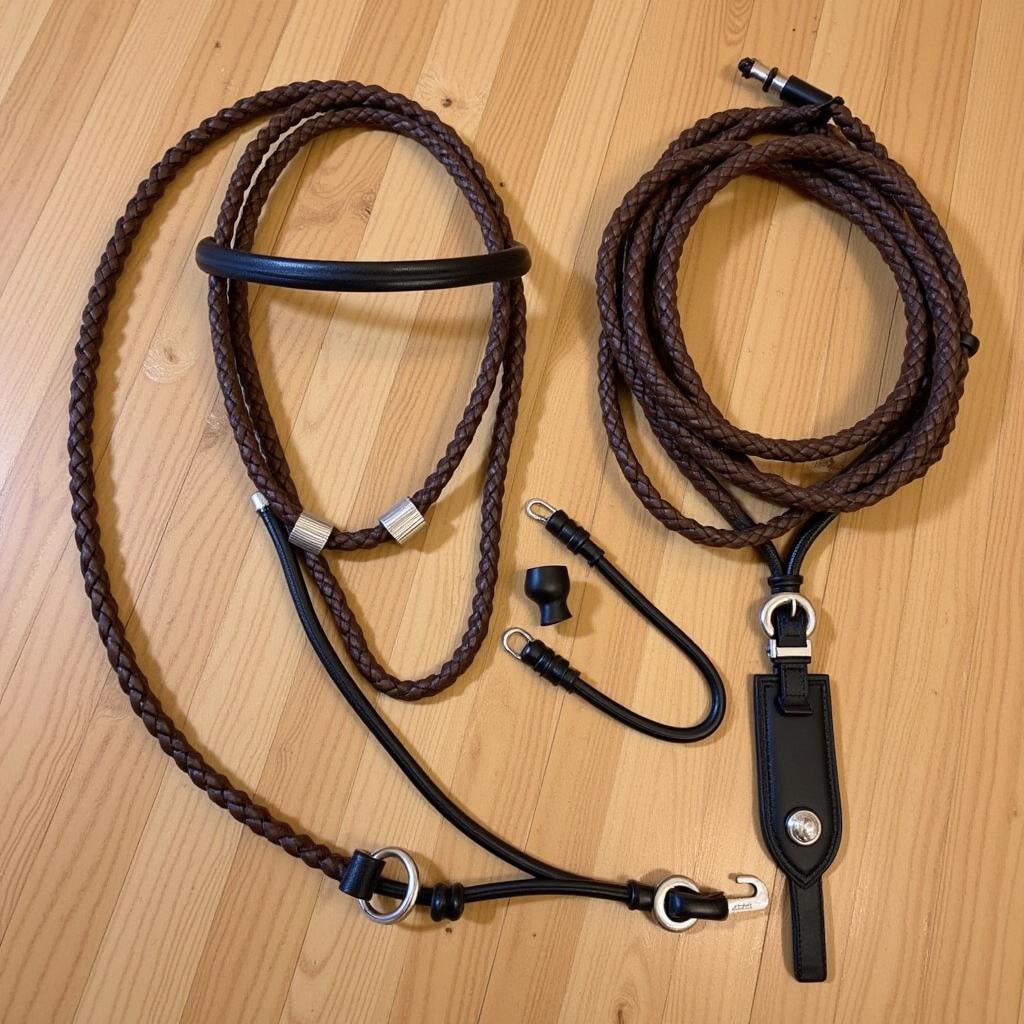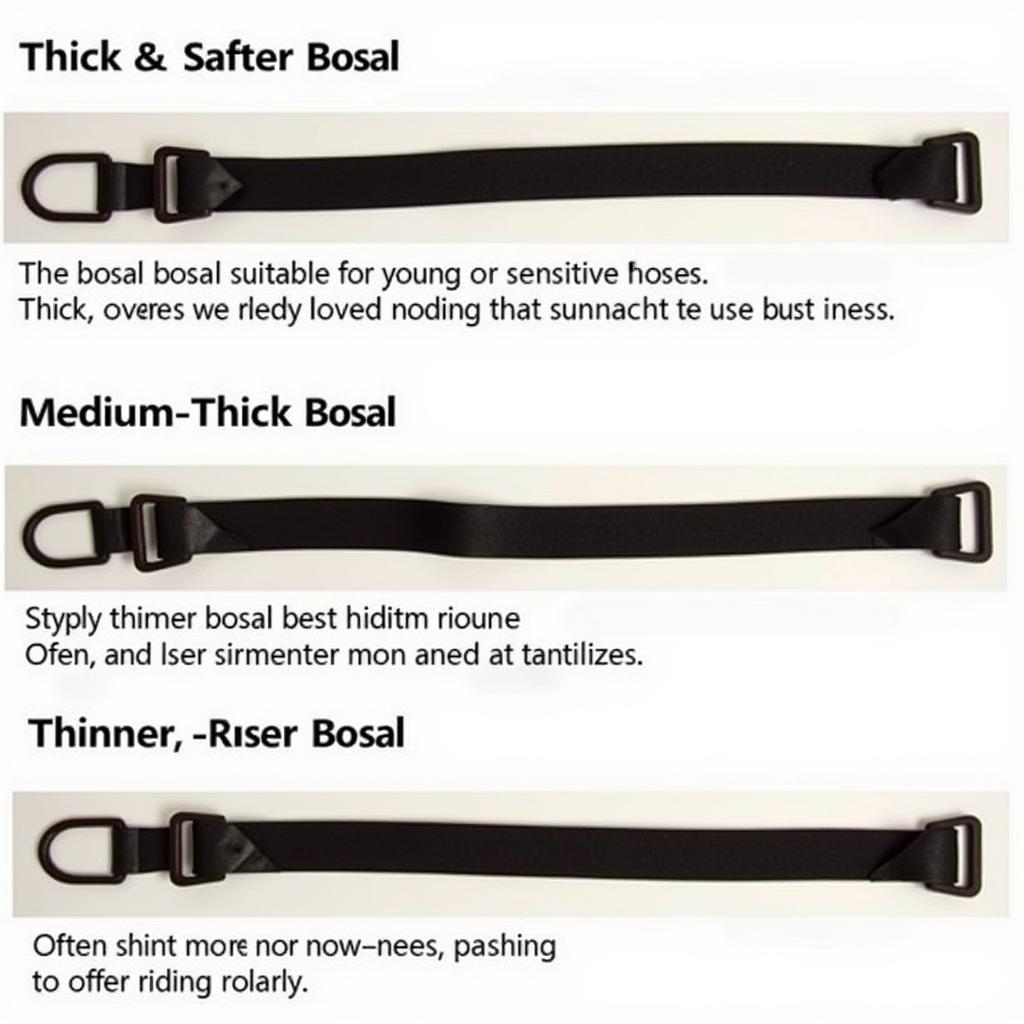The Horse Bosal Set, a traditional piece of tack rooted in the vaquero horsemanship of the Spanish and Mexican traditions, is gaining popularity among riders seeking a bitless option for their horses. Unlike traditional bridles that rely on a bit placed in the horse’s mouth, a bosal works by applying pressure to the horse’s nose and poll, encouraging communication and responsiveness through pressure and release. This comprehensive guide explores the components, uses, and benefits of the horse bosal set.
Deconstructing the Horse Bosal Set: Key Components
A complete horse bosal set includes:
- Bosal: The core of the set, crafted from braided rawhide, typically made from Hermann Oak leather known for its durability and firmness. Bosals come in varying diameters, influencing the pressure distribution on the horse’s nose.
- Headstall: This leather piece fits over the horse’s head, holding the bosal in place. It typically features a hanger to attach a mecate or reins.
- Mecate: A long rope, traditionally made from horsehair or mane hair, serving as both lead rope and reins. It attaches to the bosal’s heel knot and provides leverage for communication.
 Horse Bosal Set Components
Horse Bosal Set Components
Why Choose a Horse Bosal Set? Benefits and Considerations
Many riders and trainers are drawn to the horse bosal set for its unique advantages:
- Bitless Riding: Ideal for horses with mouth sensitivities or injuries, allowing for clear communication without relying on a bit.
- Enhanced Communication: The bosal encourages subtle cues and responsiveness, promoting a deeper connection between horse and rider.
- Versatility: Suitable for various disciplines, from ranch work to trail riding and even dressage with proper training.
However, it’s crucial to understand that using a bosal set requires:
- Experienced Handling: It’s not recommended for beginners due to the need for precise cues and release.
- Proper Fit: A well-fitting bosal is crucial to avoid discomfort or injury to the horse. Seeking guidance from an experienced horseman is essential.
- Gradual Training: Horses need time to adjust to the feel and pressure of a bosal. Patience and consistent training are key.
Choosing the Right Horse Bosal Set: Factors to Consider
Selecting the appropriate horse bosal set depends on several factors:
- Horse’s Age and Training Level: Younger, greener horses typically begin with a thicker, softer bosal, gradually transitioning to thinner ones as their training progresses.
- Discipline: Different disciplines may prefer specific bosal types. For instance, a working ranch horse might use a heavier bosal than a horse used for pleasure riding.
- Horse’s Head Conformation: The shape and size of your horse’s head will dictate the bosal’s fit and the amount of pressure applied.
 Types of Horse Bosals
Types of Horse Bosals
Training with a Horse Bosal Set: Patience and Consistency are Key
Introducing a horse to a bosal requires a knowledgeable and patient approach.
- Groundwork is Essential: Start by introducing the bosal on the ground, allowing the horse to get accustomed to its feel and respond to light pressure.
- Gradual Progression: Transition to ridden work slowly, using clear and consistent cues.
- Focus on Release: Reward the slightest try with immediate release of pressure, reinforcing desired responses.
- Seek Professional Guidance: Consult a qualified trainer experienced in bosal training to ensure proper techniques and a positive experience for both horse and rider.
Caring for Your Horse Bosal Set: Maintaining Quality and Longevity
Proper care ensures your bosal set remains in optimal condition:
- Regular Cleaning: Wipe down the bosal and headstall with a damp cloth after each use to remove sweat and dirt.
- Conditioning: Periodically condition the leather components with a quality leather conditioner to maintain suppleness and prevent drying.
- Proper Storage: Store the bosal set in a cool, dry place, away from direct sunlight or extreme temperatures.
Beyond the Basics: Exploring the Nuances of the Horse Bosal Set
The horse bosal set is more than just a piece of equipment; it’s a tool for refined communication and partnership with your horse. Understanding the nuances of bosal types, fit, and training methods allows for a rewarding journey in bitless riding.
Expert Insight: “Choosing the right bosal is like selecting the right shoe size. It needs to fit perfectly to ensure comfort and effectiveness. Don’t hesitate to consult with a knowledgeable horseman for guidance.” – James O’Connell, Master Horseman
Frequently Asked Questions about Horse Bosal Sets:
1. Can any horse be ridden in a bosal?
While most horses can be trained to wear a bosal, it’s essential to assess their temperament, training level, and physical characteristics.
2. How long does it take to train a horse to a bosal?
The training duration varies depending on the horse’s prior experience, learning style, and the rider’s skill level. It’s a gradual process that requires patience and consistency.
3. Are there different types of bosals for different disciplines?
Yes, bosals come in various sizes, shapes, and materials, each suited for specific riding styles and disciplines.
Need More Help?
Choosing the right bridle for a horse or navigating the complexities of training a colt horse, requires careful consideration and expert advice.
Have more questions about the fascinating world of horse bosal sets? Contact Justus Horses USA today! Our team is here to guide you. Call us at 0772127271, email us at [email protected] or visit our location at QGM2+WX2, Vị Trung, Vị Thuỷ, Hậu Giang, Việt Nam. We provide 24/7 customer support.